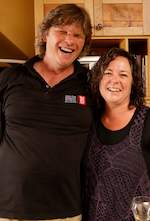Bartho's delight in sauvignon blanc dates back to his early days of winemaking. Having started his career with stints at cooperative cellars Rooiberg in Robertson and Romansrivier near Wolseley/Ceres, he arrived in the Walker Bay district in 1993 as winemaker at Wildekrans near Bot River.

Wildekrans delivered grapes to Villiersdorp co-operative winery. When Bartho Eksteen started bottling small amounts of white wines, including an unwooded and wooded sauvignon blanc, he became the first winemaker in the fairly new area of Bot River in the modern era to do so.
This was the time he inaugurated his Sauvignon Blanc Celebration. In its twentieth year in 2012, it started as a small group of wine writers gathered for an informal tasting of top local wines alongside some leading overseas proponents.
Today it's a fully fledged, acknowledged benchmarking exercise, comprising an annual workshop led by an international sauvignon blanc specialist winemaker.
At the end of the 1997 harvest, a change in farm management determined a direction that someone of firmly held convictions like Bartho 'was not happy with' and he decided to move on. 'It was a wrench. My heart was in that farm,' he says with characteristic honesty and undisguised emotion.
Big Bartho of the booming baritone and his petite, dark-haired wife Suné are intrepid spirits with a philosophical world-view. They left the farm and settled in Hermanus.
Bartho started consulting for various wineries, including Newton Johnson in the Hemel-en-Aarde Valley. In exchange for instructing Dave Johnson's son Gordon in the art of winemaking, he vinified his first Bartho Eksteen Wines, introduced in 1998, with a highly rated sauvignon blanc.
The grapes came from cool-climate sites across the Cape winelands. From this he gained experience working with sauvignon from most of the cooler areas, at the same time discovering many cool pockets in the warmer regions.
He also collaborated with farmers, experimenting on one Hemel-en-Aarde property with planting three new clones of shiraz on terraces at different altitudes, according to each clone's. ripening time, so that he could harvest all at the same time.
When both Newton Johnson and the Barthe Eksteen brand expanded to the point that Bartho needed bigger cellar space, Bartho Eksteen Wines, by then including an equally acclaimed Shiraz, found a home in a warehouse in the industrial area on the outskirts of Hermanus.
These and other wines from the burgeoning Walker Bay wine district, including top labels from further afield, were available for tasting, sale and distribution through the Eksteen's stylish little specialist wine shop in Hermanus called Wine & Company, which they eventually sold.
Friendships and Partnerships
At the end of 2004, Eddie Theron, who had developed Waboomsrivier near Stanford into a red wine farm, put Bartha in touch with new owners Johan and Mariette Pretorius. Bartha made wines for them in his small 'industrial' cellar and encouraged them to plant white varieties. They subsequently bought neighbouring Waterval and extended their plantings to Rhone varieties plus more sauvignon blanc.
'When I'm not playing with sauvignon blanc, I love blending.'
Says Bartho: 'My connection with Wildekrans was probably more one of the heart. The Sondagskloof property, on the other hand: well, it's quite simply an absolutely fantastic farm!'
Bartho is equally enamoured of the Hermanuspietersfontein cellar. It's workmanlike on the outside. He likes to point out that the feet of the stainless steel tanks are visible through floor-level windows from the increasingly busy R43 leading into the holiday mecca that is Hermanus, a world-renowned land-based whale-watcher's paradise. 'I like to think it makes motorists, sitting at the traffic lights, want to come and see what we're doing here.'
Down below, in the cool, dark underground barrel maturation room, is his private, candle-lit vinotheque, Here he, friends and fellow wine lovers sit at a trestle table tracking older vintages of Barthos's wines, as well as dipping into his wide-ranging collection.
Bartho's private collection of wines, together with farm-style cheese rounds and sides of Parma ham and other goodies requiring storage at optimal temperature, are stacked floor to ceiling along all four walls of a walk-in, air-conditioned pantry converted from a section of the front stoep of their home.
 Alikreukel (giant periwinkles) trio of tasty cakes, creamy cubes and salsa strips recipe by Bartho Eksteen paired with Die Bartha or Hermanu...
Alikreukel (giant periwinkles) trio of tasty cakes, creamy cubes and salsa strips recipe by Bartho Eksteen paired with Die Bartha or Hermanu... Baked ox tongue with mustard sauce recipe by Bartho Eksteen served with vegetables and paired with Herrnanuspietersfonrein Swartskaap wine....
Baked ox tongue with mustard sauce recipe by Bartho Eksteen served with vegetables and paired with Herrnanuspietersfonrein Swartskaap wine....